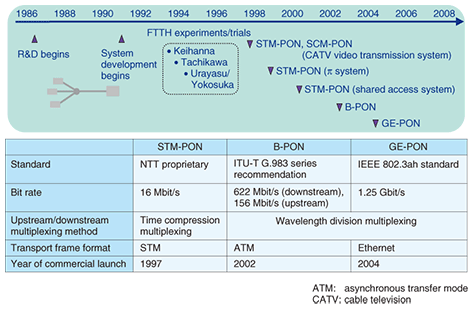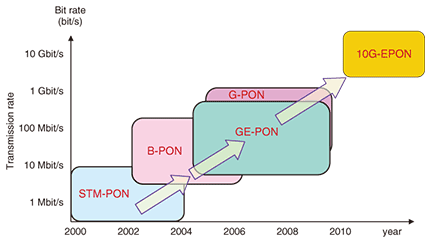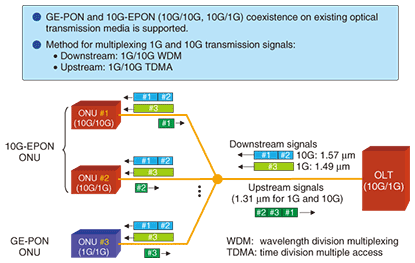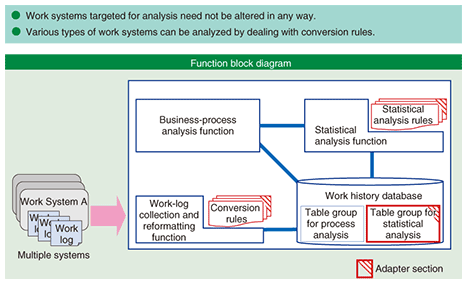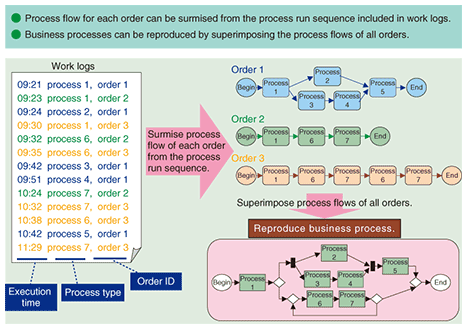 |
|||
|
|
|||
|
Special Feature: NTT Tsukuba Forum 2008 Workshop Lecture 1 Vol. 7, No. 6, pp. 6–11, June 2009. https://doi.org/10.53829/ntr200906sf1 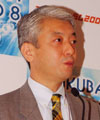 Optical Access Systems and OperationsAbstractThis article describes a method for enabling the coexistence of 10G-EPON (10-Gbit/s Ethernet passive optical network) and the current GE-PON (Gigabit Ethernet passive optical network) as an example of optical access systems development. It also describes technology for visualizing and analyzing business processes using work logs as an example of operations systems development. The three articles in this Special Feature are based on presentations given at the Tsukuba Forum 2008 Workshop held on October 16, 2008.
1. IntroductionWhile the deployment and promotion of FTTH (fiber-to-the-home) services is underway with the aim of achieving a low-cost, high-quality, broadband network environment, technology is still under development. To keep up with the recent increases in the number of broadband users, not just for personal computers (PCs) but also for TVs, game devices, and other non-PC equipment, even more efforts must be devoted to technology development. This state of affairs calls for FTTH operations and management technologies that can provide a more reliable, faster, and less costly network. As specific examples, technologies are being developed to multiplex services of different quality levels and to monitor and control individual services. Fiscal year 2008 saw the number of FTTH users in Japan increase to more than 13 million, surpassing the number of ADSL (asymmetric digital subscriber line) users for the first time. Indeed, from FY2006 on, the number of FTTH users has been increasing at a brisk pace of 800,000 per quarter. Even within the limits of the NTT Group, the number of FLET’S Hikari users has already passed the 10-million mark overtaking FLET’S ADSL. 2. Optical access systems2.1 Development of PON systemsIt has been more than twenty years since NTT began its research and development of passive optical network (PON) systems. NTT began the development of actual systems at the beginning of the 1990s, and after completing a series of field tests, it commercialized its proprietary synchronous transfer mode version (STM-PON) (Fig. 1). The STM-PON system supports bidirectional digital transmission. In the STM format, NTT has also developed (1) a wavelength multiplexing system in the form of subcarrier multiplexing (SCM-PON) for multichannel video transmission in the downstream direction, (2) the STM-PON (π system) featuring a function for providing telephone services and (3) STM-PON (shared access system) for business users. With the aim of improving bit rates while keeping abreast of international standards, NTT then went on to develop a broadband version (B-PON) as well as a Gigabit Ethernet version (GE-PON), which is now the mainstream system. In this manner, PON systems have evolved gradually over time, and a number of difficult problems have had to be solved along the way.
In a PON system, the relationship between users and the NTT office is similar to that between a lecturer and an audience. The lecturer speaks to all members of the audience in a hall at the same time, which means to say that the lecturer is unable to restrict his presentation to only one person. In addition, the lecturer cannot take questions from two or more members of the audience at the same time—such questions must be taken in order one person at a time—and any one person must be prevented from monopolizing the question-and-answer time. Furthermore, the difference in volume between a lecturer who speaks with a loud voice and one who speaks with a quiet voice should be adjusted (by the microphone and amplifier gain): in the case of a PON system, this is performed at the office side. However, while it’s easy to transmit the same messages to multiple users from the office side, communicating with only a specific user requires either encryption technology or technology that enables signals to be sent to only the user in question. In the light of the above problems, researchers initially thought that it would be difficult to implement PON technology, but in the end, NTT succeeded in developing practical PON systems, which, as a result of NTT leadership, are now finding widespread use around the world. 2.2 GE-PONThe GE-PON system connects an optical line terminal (OLT) on the NTT office side with optical network units (ONUs) on the users’ side by using an optical splitter with a maximum of 32 branches. It has the following features:
The system uses the 1.49-µm band in the downstream direction and the 1.31-µm band in the upstream. To avoid collisions in the upstream direction when signals from multiple ONUs converge at the optical splitter, the system controls the timing for signal transmission at the OLT. 2.3 10G-EPONThere has been a lot of study and research for the next-generation PON system to follow after GE-PON, and several directions can be considered. The technology that NTT is actively promoting is 10G-EPON (10-Gbit/s Ethernet PON), which can achieve a transmission speed ten times that of GE-PON (Fig. 2).
Three preconditions were set for the development of the 10G-EPON system: first, existing optical transmission media (32 transmission media branched using an optical splitter) must be used; second, the system must be able to coexist with the existing optical access system (GE-PON, optical video delivery system, etc.); and third, upgrading from the existing PON system must be relatively easy. In short, what is needed is technology that can provide 10G-EPON quality while supporting existing GE-PON users and optical video delivery users in the usual way. Standardization of the 10G-EPON physical layer is currently being studied at the IEEE P802.3av 10G-EPON Task Force, and two specifications for transmission speed are being established: symmetric (10 Gbit/s downstream and upstream) and asymmetric (10 Gbit/s downstream and 1 Gbit/s upstream). For the symmetric and asymmetric systems to coexist, two requirements must be satisfied: first, wavelengths must be allocated in a way that prevents interference between transmissions from the two systems, and second, transmissions characteristics must not deteriorate as a result of higher speeds. In terms of transmission characteristics, NTT is developing technology that makes use of enhanced laser diodes and photodiodes to prevent a drop in sensitivity even at higher bit rates. This technology is expected to improve transmission characteristics by about 10 dB. 2.4 GE-PON and 10G-EPON coexistence technologyTo enable GE-PON and 10G-EPON (10G/10G or 10G/1G*) to coexist, we use different wavelength bands in the downstream and upstream directions for multiplexed processing of signals (Fig. 3). To send signals continuously to all ONUs in the downstream direction, the 1.57-µm wavelength is allocated to 10G and the 1.49-µm wavelength to 1G. These signals are identified on the ONU side by wavelength filters (1G/10G wavelength division multiplexing). In the upstream direction, the 1.31-µm wavelength is allocated to both 1G and 10G signals. Transmission timing is controlled on the OLT side, and the signals are received while instantaneously distinguishing between the 1G and 10G transmission speeds (1G/10G time division multiple access).
Thus, each signal type is assigned a different wavelength: 1.31 µm for 1G/10G upstream signals, 1.49 µm for 1G downstream signals, 1.55 µm for video downstream signals, and 1.57 µm for 10G downstream signals. Even signals used in maintenance work have their own wavelength of 1.65 µm. 3. Operations systems3.1 Visualization and analysis of business processesAs an example of operations technology, we are developing visualization and analysis technology for business processes using work logs accumulated by computer-based processes. System logs often constitute a gold mine of information, and if that information is broken down, business processes can be automatically visualized and systems analyzed to support improvements in work procedures. Conventional system analysis has relied on techniques that could hardly be called systematic such as reading over a system’s design manual, conducting interviews, and taking measurements with a stopwatch. The results derived from such analysis cannot help but be subjective in nature. On the other hand, using actual logs as input enables objective system evaluation. In visualizing existing business processes by a business-process analysis function, the first step is to perform a statistical analysis according to previously established statistical analysis rules. The next step is to collect the various system work logs and analyze them after reformatting the log information into analysis-friendly data according to conversion rules established beforehand. Inferences and reproductions of actual work processes can now be made (Fig. 4).
A key feature of this analysis system is that various work systems can be analyzed, without any changes having to be made to them, by simply dealing with conversion rules. 3.2 Business-process inference algorithmInformation that is particularly necessary for making inferences about business processes consists of order numbers, the time that each of those orders was executed, and the type of processing performed. These three pieces of information can be used to uncover the process run sequence for each order and to surmise the process flow. The process flows for all orders can then be superimposed to reproduce business processes (Fig. 5). Conditions can also be attached to enable the entire work flow to be understood or to focus in on only specific locations. For example, system-dependent information can be used to reproduce the interaction between systems, or department- or company-related information can be used to reproduce the links between departments or companies.
Business processes that have been visualized in this way can now be analyzed from many angles. For example, they can be used to uncover problem areas such as the unexpected repetition of processes or jumps to processes different from the original plans. The expected and actual flows can be compared and locations suitable for improvement can be automatically extracted so that improvement proposals can be studied and fed back to the system in the form of corrections. In this way, a work improvement cycle can be achieved. 4. ConclusionThe increase in non-PC usage accompanying the rapid spread of FTTH is creating demand for faster, more comfortable, and more diversified FTTH services. To this end, NTT Access Network Service Systems Laboratories is researching and developing many technologies with a focus on 10G-EPON and business process visualization, as introduced here. NTT aims for early implementation of these technologies to provide services that achieve an even higher level of user satisfaction. ProfileCareer highlightsProject Manager, Fourth Promotion Project, NTT Access Network Service Systems Laboratories. Hiroshi Uno received the B.S., M.S., and Ph.D. degrees from Nippon University, Tokyo, in 1982, 1984, and 2004, respectively. His study areas were access network systems and operations. He was an invited professor of Soochow Univ. in China in 2004 and a consultant professor of Huazhong Univ. of Science and Technology in China in 2005 and 2006. He is a member of IEEE and the Institute of Electronics, Information and Communication Engineers (IEICE) of Japan. He is a Chair of the Technical Committee on Information and Communication Management, IEICE. |
|||








